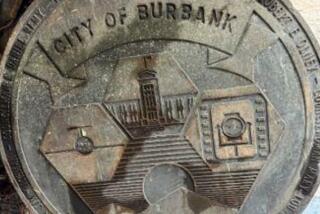City Salvage Unit Is Way Station for Disposal of Unwanted Equipment
When a desk that belongs to the city of Los Angeles can no longer perform its duties, bureaucracy handles it in the way it knows best.
It goes to another bureaucracy, the General Services salvage unit.
So do chairs locks, bookcases and small animal anesthesia machines. In Los Angeles, such items often meet unglamorous fates and Clarence Williams, supervisor of salvage, is the person who guides them out of civic service..
As principal storekeeper of the salvage unit, Williamsâ domain is in the belly of Pipertech Center, a giant building among the warehouses just off Cesar Chavez Avenue east of downtown. There, Williams catalogs and organizes the castoffs before sending them to auctions, giveaways or scrap yards or selling them to other city departments.
The salvage unit has existed since 1925. Some items are new, others old. Still others are alive--the city zoo processes its animal sales through salvage.
âYou know those mounted police officers with their horses? And those police dogs?â Williams asked. âWhen the horses and dogs get old, we cover them too.â Neither the zoo nor police animals are kept in the warehouse, although the department records their sale.
Discarded items meet a variety of fates. Zoo animals often are bought by other cities, while those retired by the LAPD often go to police officers. Many inanimate objects are sold for about $1 apiece to other government departments; the rest are sold at auctions every five weeks to private citizens or small companies. These sales brought in $6.5 million during the 1998-99 fiscal year.
Unsold items are shipped to a landfill and reincarnated as scrap.
At any given time, the salvage unit holds 1,200 tires, 20 to 50 computers, 75 chairs and 50 desks, said Bill Griggs, director of materials and Williamsâ boss.
A list of these goods is a lesson in the vast and obscure duties of city government. In the warehouse, there are giant tires from city firetrucks and a collection of about a dozen seat bottoms from LAPD cars. Two 5-foot-tall plastic boxes on wheels--fitted with computer monitors--keyboards and orange racing stripes, stand abandoned.
âTheyâre old engineering analyzers for tuneups,â Williams said. The Police Department had used them to service its fleet.
Nearby, a pair of 3-foot-tall canisters, covered with valves and pipes, are a mystery to Williams, supervisor of the salvage unit for more than a year. âLooks like some kind of anesthesia stuff, to put somebody to sleep,â he said.
Griggs reads its label: âSmall animal anesthesia,â he said.
âThat must belong to Animal Regulation,â Williams said.
Williams and Griggs move on, past the dusty cribs from a city day-care center, an ice machine, piles of bricks and a set of old medical examination chairs, seized when a doctor occupying a suite in a Department of Transportation building didnât pay his rent. âTheyâre storing them here until they figure out what to do with them,â Williams said.
The salvage unit even accounts for vehicles seized by the LAPD, as well as old city vehicles. They, like the animals, are not housed in the building. Last year, the salvage unit auctioned off 1,864 vehicles.
âWeâve got helicopters, drug airplanes,â Williams said. âWeâve got black-and-whites, city vehicles, all city trucks. Mercedes, Buicks, Fords, anything in a drug seizure.â
Carl Stude, a city plumbing supervisor, browses through shelves at the center of the warehouse.
Although Stude has been with the city for years, he has only known about the salvage unit for the last four months. Since then, he has come in every other week. City funds are tight, but his office could use more furniture. This time heâs looking for a printer table.
âYou know,â he said, âa few years ago, I wrote [to the city] and suggested that they have something like this salvage area.â
âWell, weâve always been here,â Williams replies and checks his watch. Itâs nearly closing time, he says. A large truck, finished dumping a load of whatever, rolls out of the loading bay and into the sun.
More to Read
Sign up for Essential California
The most important California stories and recommendations in your inbox every morning.
You may occasionally receive promotional content from the Los Angeles Times.










